October 2022
Climate Art and Stories Campaign
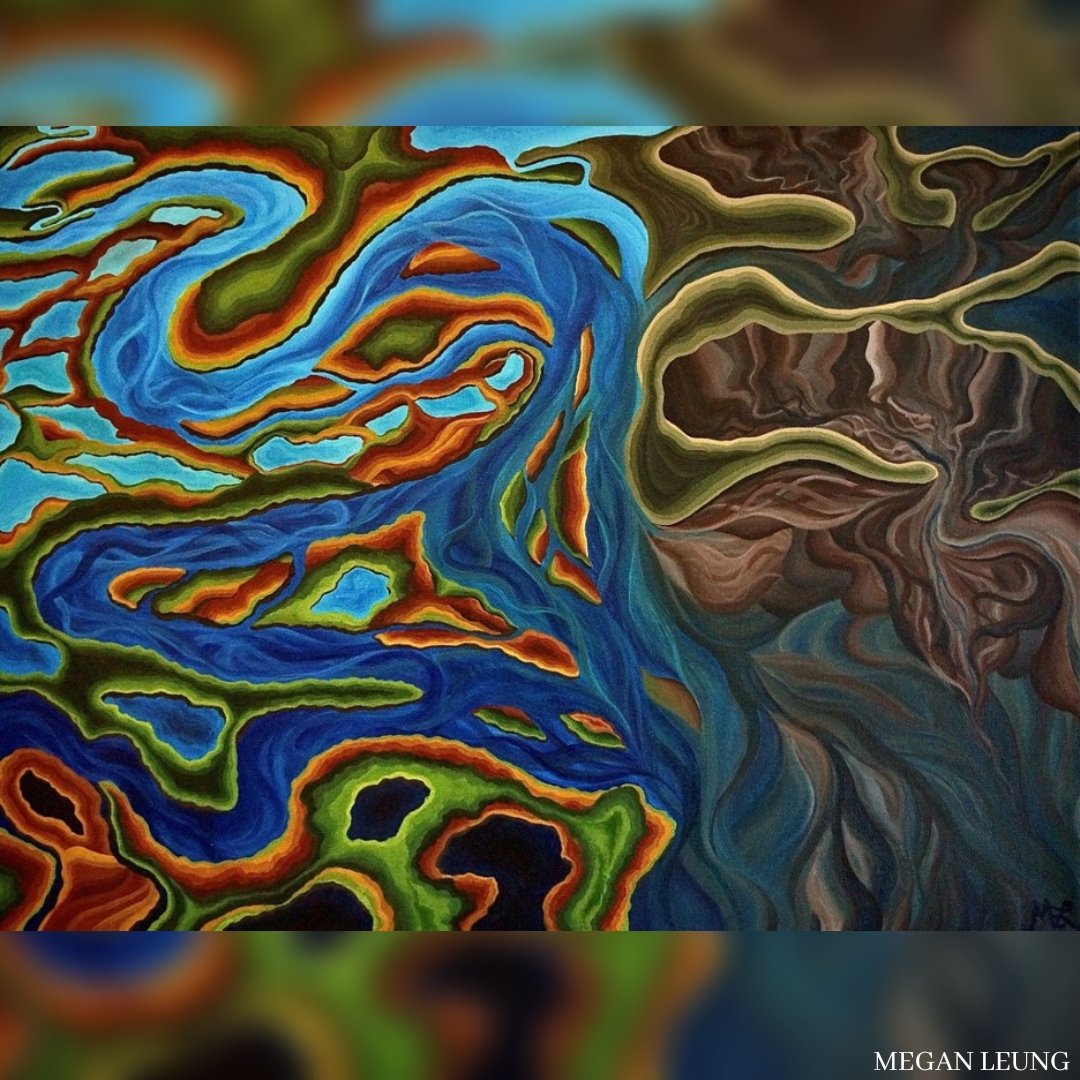
Throughout the month of October, the IFRC, Red Cross Red Crescent Climate Centre, and the ENBEL Consortium shared art and personal stories related to climate change.
The following images and text show the amazing work and aspirations of people around the world to spread hope, create awareness, and progress climate action.
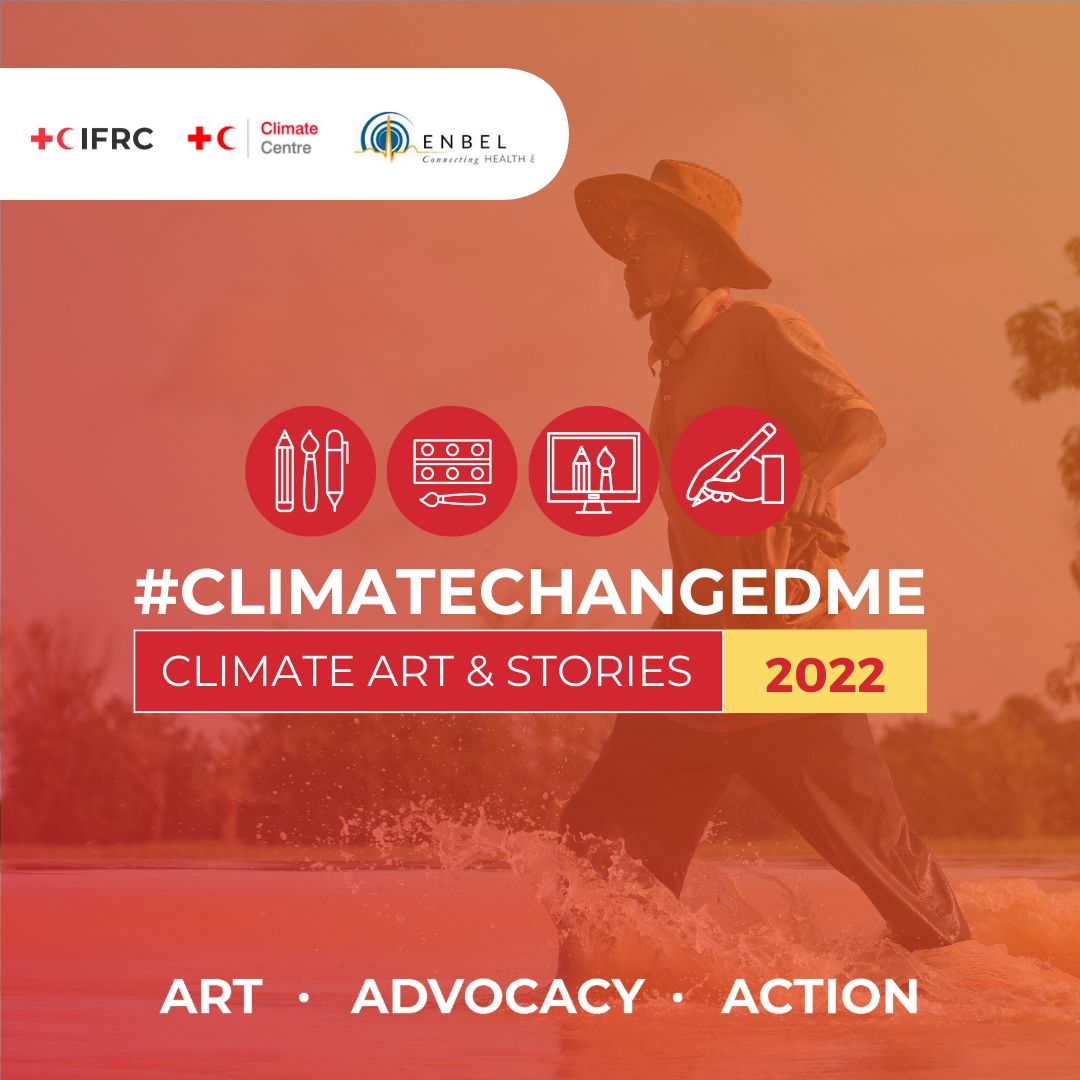
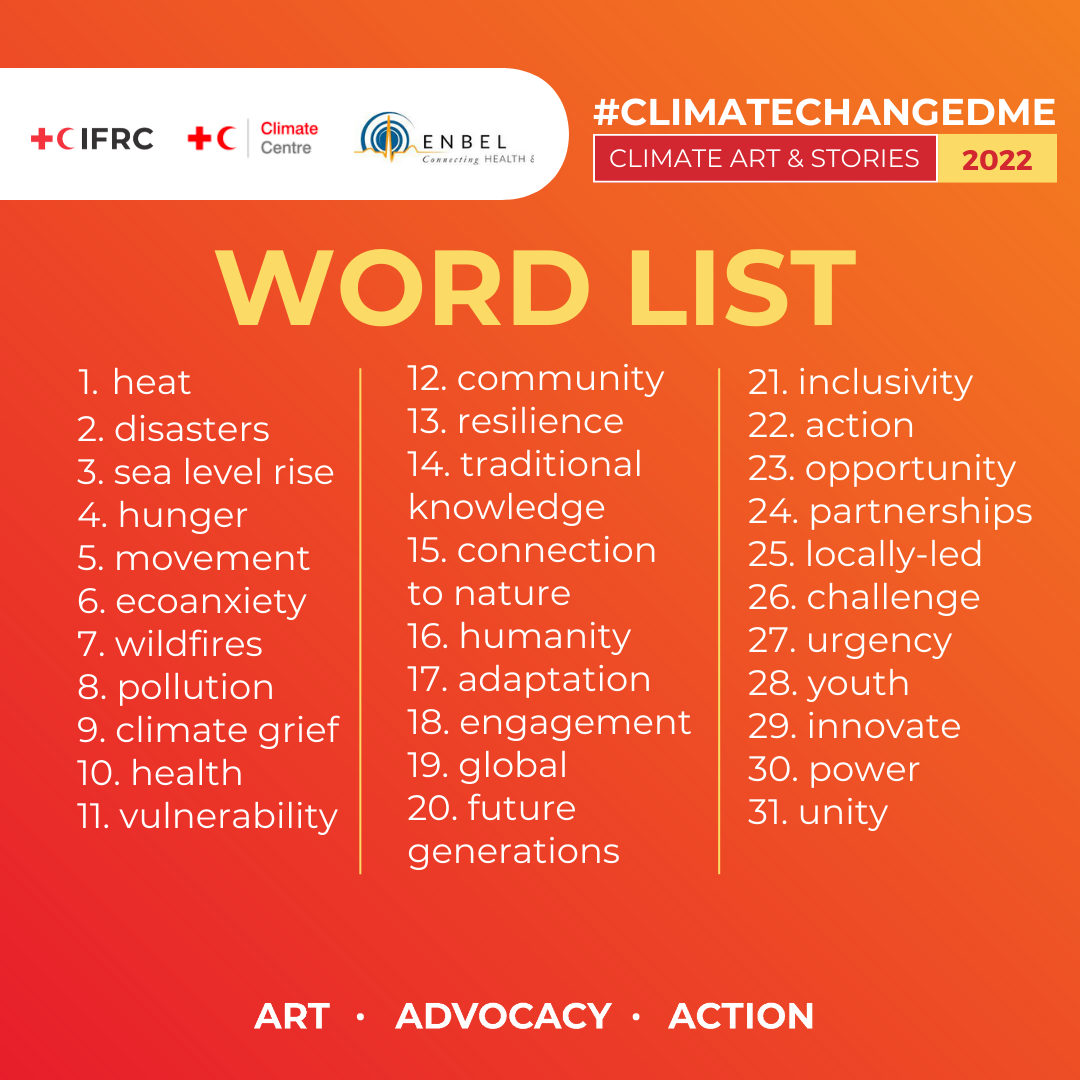

1
Long ago, during a holiday, my husband and I prepared for hot day at the ancient Acropolis in Greece. I thought we could easily withstand the heat with water and sunscreen.
Unfortunately, I couldn’t. I was untouched by all the beauty, the history, the roots of democracy, simply because I could not cope with the temperature. I learned after the trip that many tourists can not make it to the top and are seriously impacted by the heat leading to heat stress or even heat stroke. Now the most famous site in the world occasionally closes if it is too hot.
This experience for me opened my eyes to something much worse. While I was just a tourist looking for a short walk in the sun, outdoor construction workers often have no choice to escape the sun, especially in countries where little protection measures are taken for outdoor workers.
Often, it would mean no income for them if they choose to stay away due to extreme temperatures. Outdoor workers are often exposed to the heat for much too long and they are not informed about the risk they face of lengthy heat exposure: permanent damage to their kidneys, often resulting in chronic illness or death.
- Fleur Monasso

2
The beginning of the environmental disaster was an unforgettable history for the people of Tunisia, specifically the state of Bizerte, when a fire broke out in the Ain Damous forest on August, 10th 2021. The fire resulted in a loss of rich vegetation cover and biodiversity. The death of many animals and the loss of homes, livelihoods, and lives.
- Dridi Asma
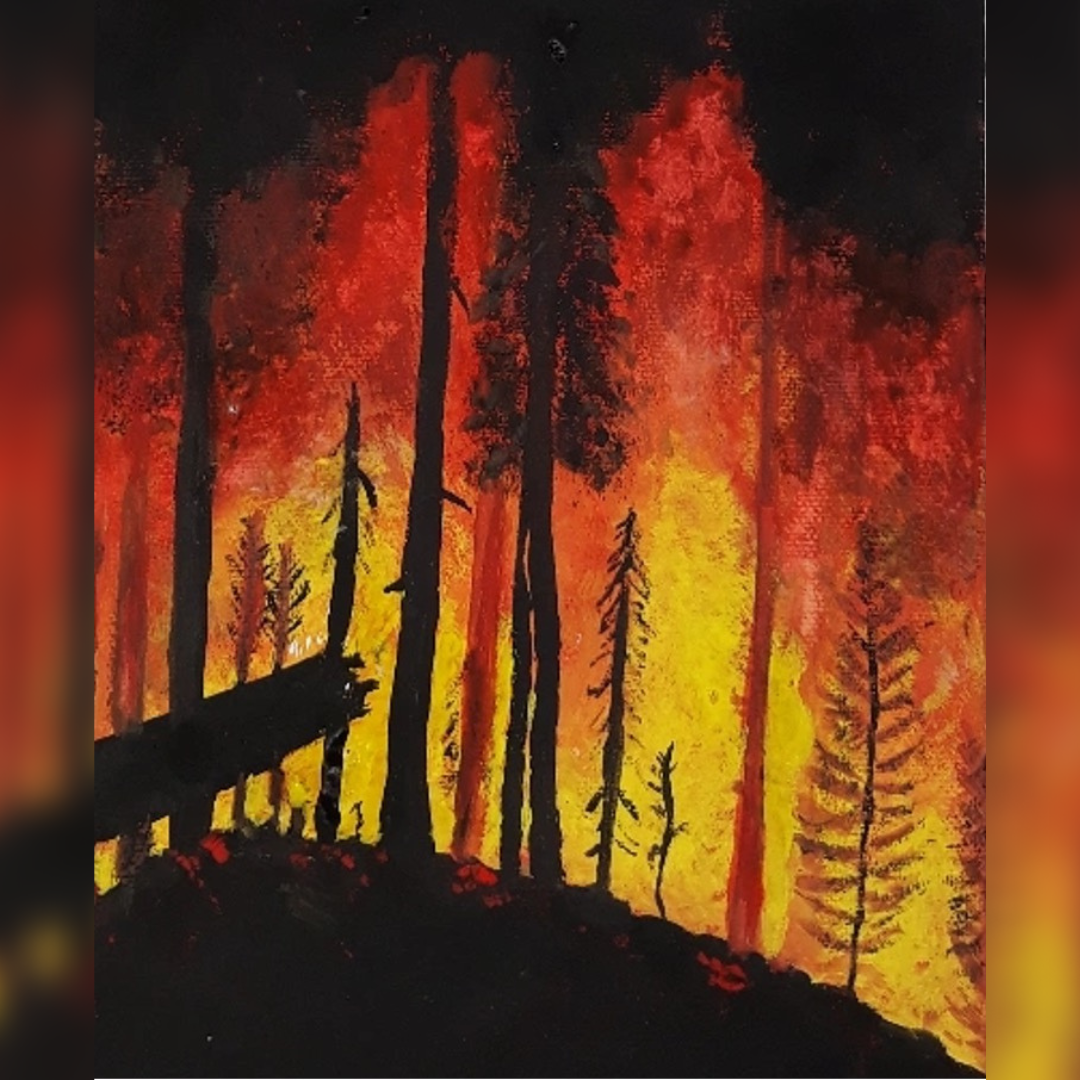
3
The tidal water touched my feet as I quickly walked across the wooden jetty and jumped into the crowded boat, the last one for the day leaving for the main island. As it starts moving, I leave behind the island of Mousuni, which was my home for the last one month.
It starts decreasing in size, little by little, until it becomes a tiny dot in the horizon before vanishing into oblivion. I found it quite fitting to be honest, almost poetic in the sense that Mousuni is expected to get inundated and lost to the sea in the coming years, due to the high rate of sea level rise in this part of the Bay of Bengal.
My work on the island over that one month consisted mainly of talking to hundreds of people who have lost their land and homes to sea level rise and riverbank erosion. It was undoubtedly one of the most humbling periods of my life, one that shaped my journey and all that I do today for climate action.
The island was inhabited mainly by wives and mothers, as they were the ones left behind to tide the cyclones and floods, while the men had migrated out in search of work. These women were fierce, despite their limited agency and access to institutional support. They were raising children in this precarious island that is surrounded by crocodile infested tidal rivers and Royal Bengal tiger infested forests. And they were facing impacts of climate change that they were not responsible for.
And when asked why they did not leave the island and migrate elsewhere, they smiled and said, “Our land is our land, and we go down with it.”
- Sayanti Sengupta
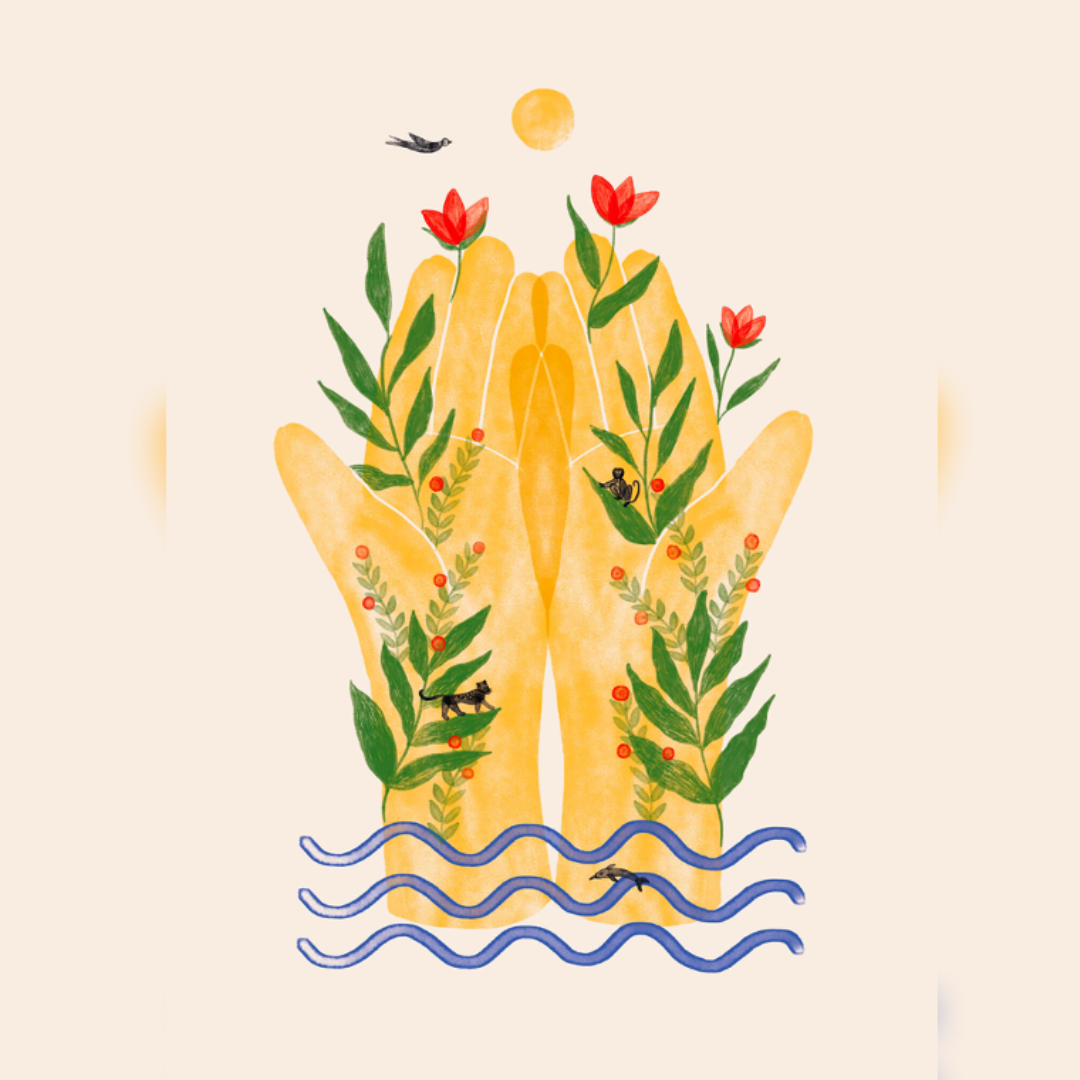
4
I finally have emergency food — emergency as in like when the world is ending…like when Zombies take over or when hell freezes over which, in Houston, I learned, can actually happen.
And we can never be too prepared — they say: Have that flashlight and that battery operated radio, have water reserved for up to three days,
enough food to last through a lifetime of poverty and oppression and still be able to store some away for a rainy day, which sometimes lasts for days and leave people stranded, or hungry, or homeless.
We know things will only get worse… we know nobody will ensure our survival… In a world that sees its future without disabled people, our survival and the survival of others like us will only matter to us
although the non-disabled will claim they tried to save us, gave us a box of food and five gallons of water, thoughts and prayers and a list of phone numbers to places we have already called and places that claim to have already helped.
But now I have “emergency food” locked away in that one room where stale memories are kept, the room occupied by the memories that hurt.
I keep my emergency food there because it becomes easier to pretend I don’t have it when the hunger pangs wake me up at night or when I’m hungry for a snack — forgetting that snacks are for those who can afford them,
or must be reserved for a disaster of some kind because living on fixed income or no income means keeping non perishable foods and non perishable hope locked away to keep ourselves from consuming it when we’re being consumed by hunger.
- Maria R. Palacios
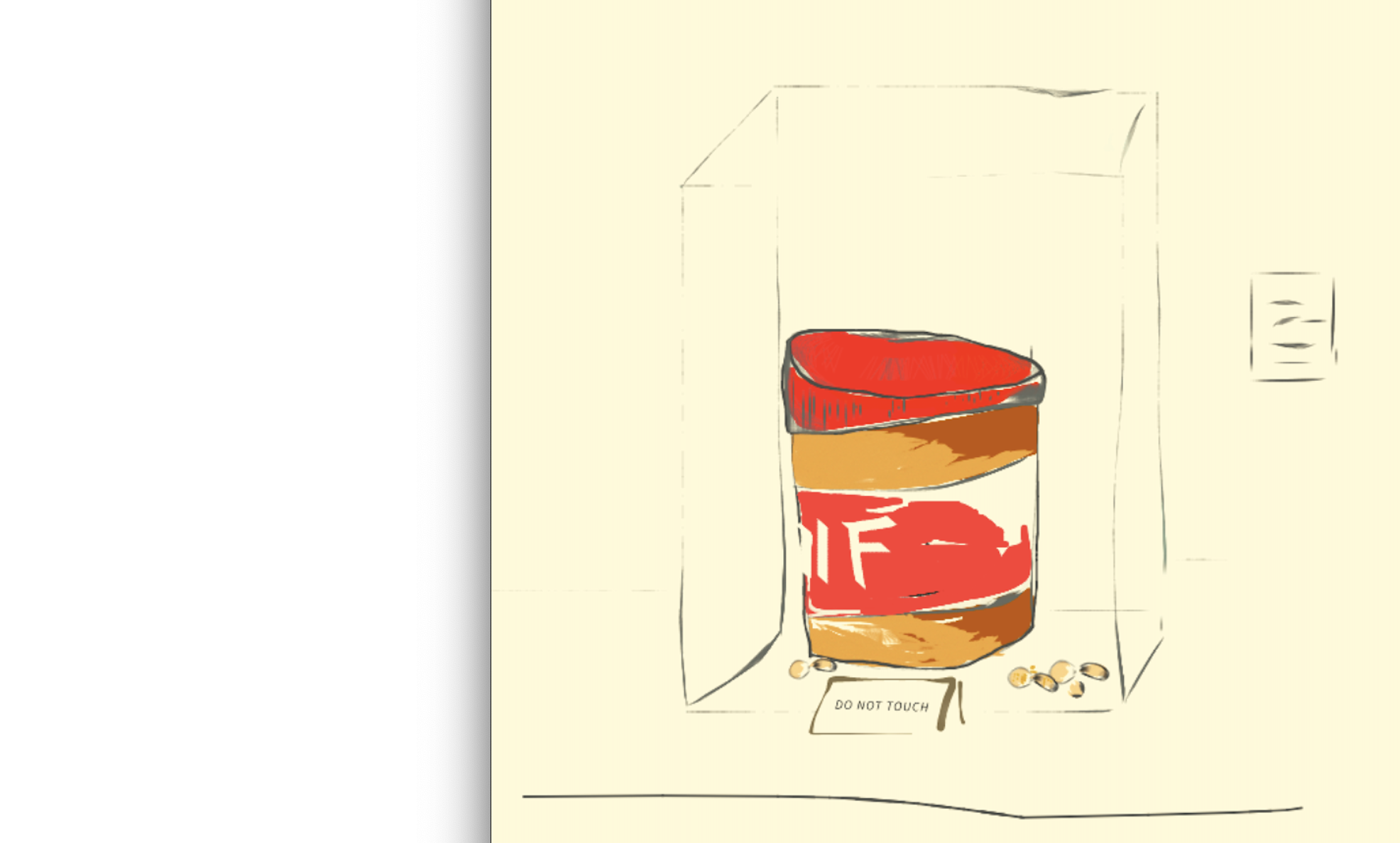
5
One day like any other day I woke up In the morning and went to my friend, I heard sudden gunshots And screaming from my house.
I rushed out there and found my father Is dying on the ground and my mother Was being humiliated by soldiers, Some of them set fire everywhere.
I came back to my friend But I found him nowhere, Seeing women and children were running I followed them without any question.
We ran for food and shelter Towards the polluted and vulnerable planet By leaving our motherland Rakhine behind Where humanity cries.
- Humayun Kabir

6
In this painting, I drew a man in isolation to represent COVID-19 and its causes of mental health issues. The woven basket on the painting represents our identity as Marshallese. I wanted to paint something that represents how COVID has affected us mentally through quarantine and the anxiety it has given us. The anxiety from COVID is similar to anxiety from climate change. Although isolation is not forced by quarantines in climate change, we have continued to be isolated from global politics and decision making.
- Hazel Peter

7
As a firefighter I've learnt that people, especially in underdeveloped areas, have less knowledge about climate change. Action and knowledge that could help save our planet and future generations.
It’s been 2 years since I've joined the fire service and I have attended a dozen bush fire calls, mostly due to people who burn those velds and bushes for unscrupulous reasons.
As the Fire brigade personnel, we have to come up with ways to curb the burning down of nature, which causes rapid unpleasant climate changes in the long run. I hope through my art, others will see the urgency and importance of climate action.
- Andile K Dube
8
The message of this painting is that climate change can be caused by man-made factories and ships. I would like the audience to see that air pollution can be caused by smoke coming from factories. The painting also shows that our ocean can be polluted by massive amounts of oil spills from ships. This pollution can cause our marine animals to lose their lives.
- Marck Conception
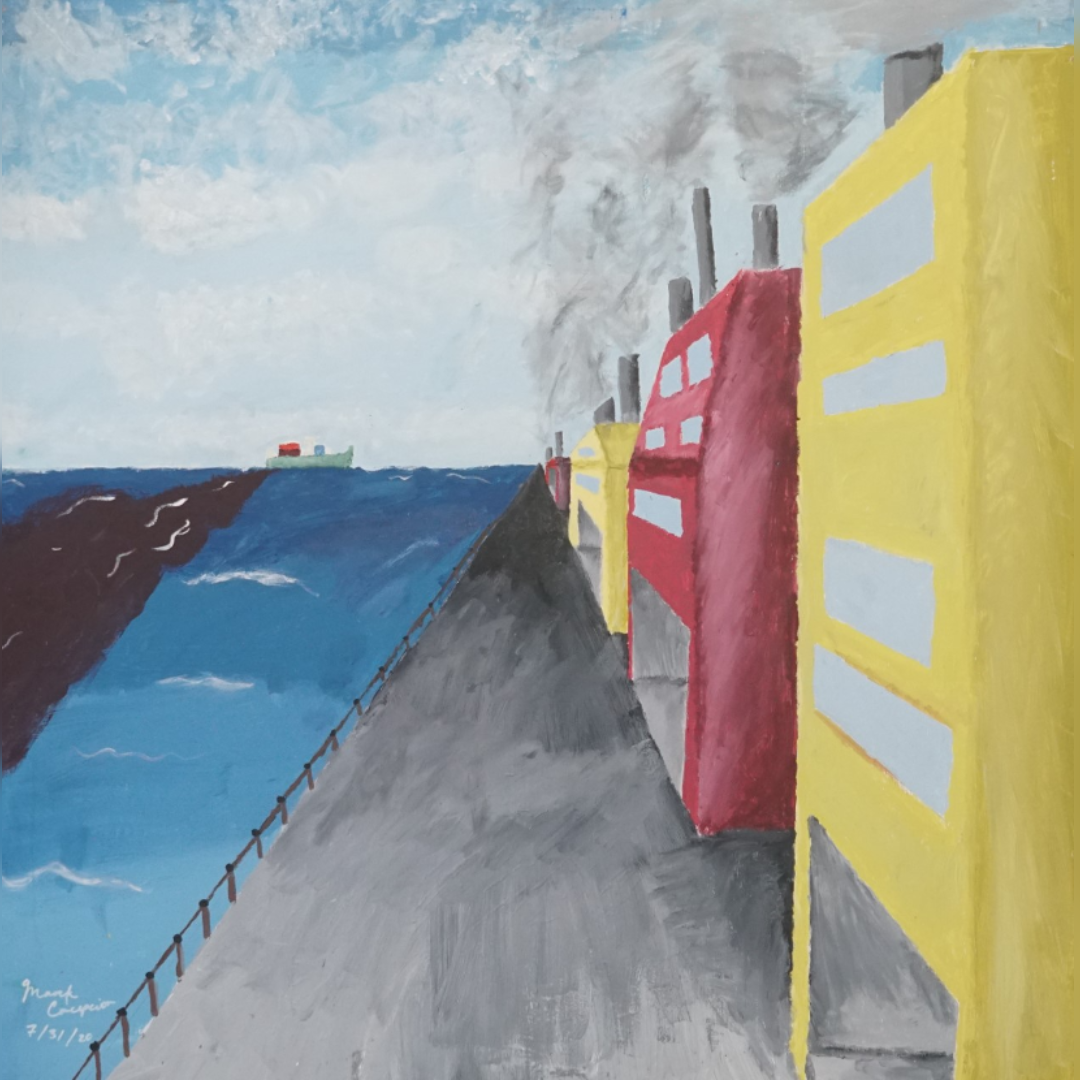
9
Awareness began for me in 1975 while helping organize a citizens’ public enquiry into a series of giant hydroelectric dam projects. Unforgettably, indigenous elders and water scientists laid out present and emerging ecological and social disasters, which included the flooding of many First Nations communities, boreal forests, and creature kin of savaged rivers and wetlands.
This version of land and water-grabbing racism with its resulting ecological crises, sparked me to join others in opposition. To the optics of my heart these troubles were in part a failure of our imaginations to fully behold the goodness and beauty that surrounds and holds us. Oblivious to our dwelling place, we collude in destroying our kin, and ultimately ourselves.
- Bob Haverluck
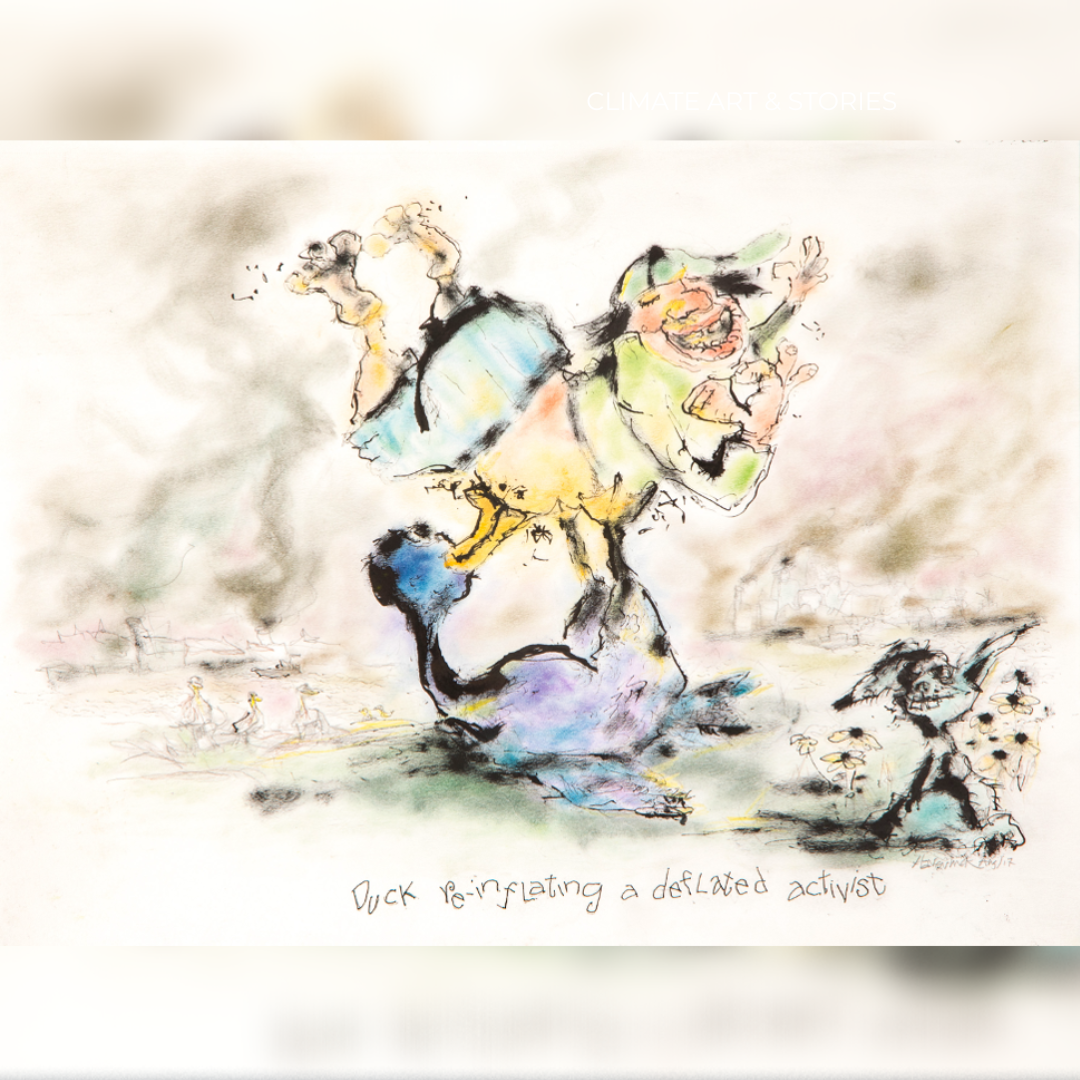
10
Staying in land-locked New Delhi, India’s Capital city, I grew up with hot, dry summer winds. The heat radiated from the tar road would burn my feet as I drove my Fiat car to work. None of the cars then came pre-fitted with air conditioners (or music!) and these were expensive add-ons.
The lu, as these dry, hot winds are locally called, started early in the day and didn’t spare our late evenings. We had learnt to live in light, airy cotton clothes, even as our hair often matted with sweat. Before going out into the blazing sun, we would gulp down the several local drinks that kept our body temperature low for a longer time. Drinks such as buttermilk or chhas, yogurt-based lassi, fruit-based kokum, black chickpea-based sattu and fresh cane juice.
Yet, in our top floor flat, despite a water-based air-cooler fitted in our window, our ceiling fan spewed hot air. This is when I began my terrace vegetable and herbs garden. The greens, to our surprise, made an amazing difference! The temperature dropped by up to 4°C in our room. As I expanded the number of pots, the fan gave up spewing hot air.
During COVID, we grew Giloy, the Ayurvedic immunity-boosting plant; walked on our terrace with greenery around us, sound of birds and an occasional butterfly; and had health drinks like soaked chia seeds with freshly plucked lemons and mint leaves. Nature, inside our city home, is reap with benefits.
- Aditi Kapoor
Artist: Ankita Singh
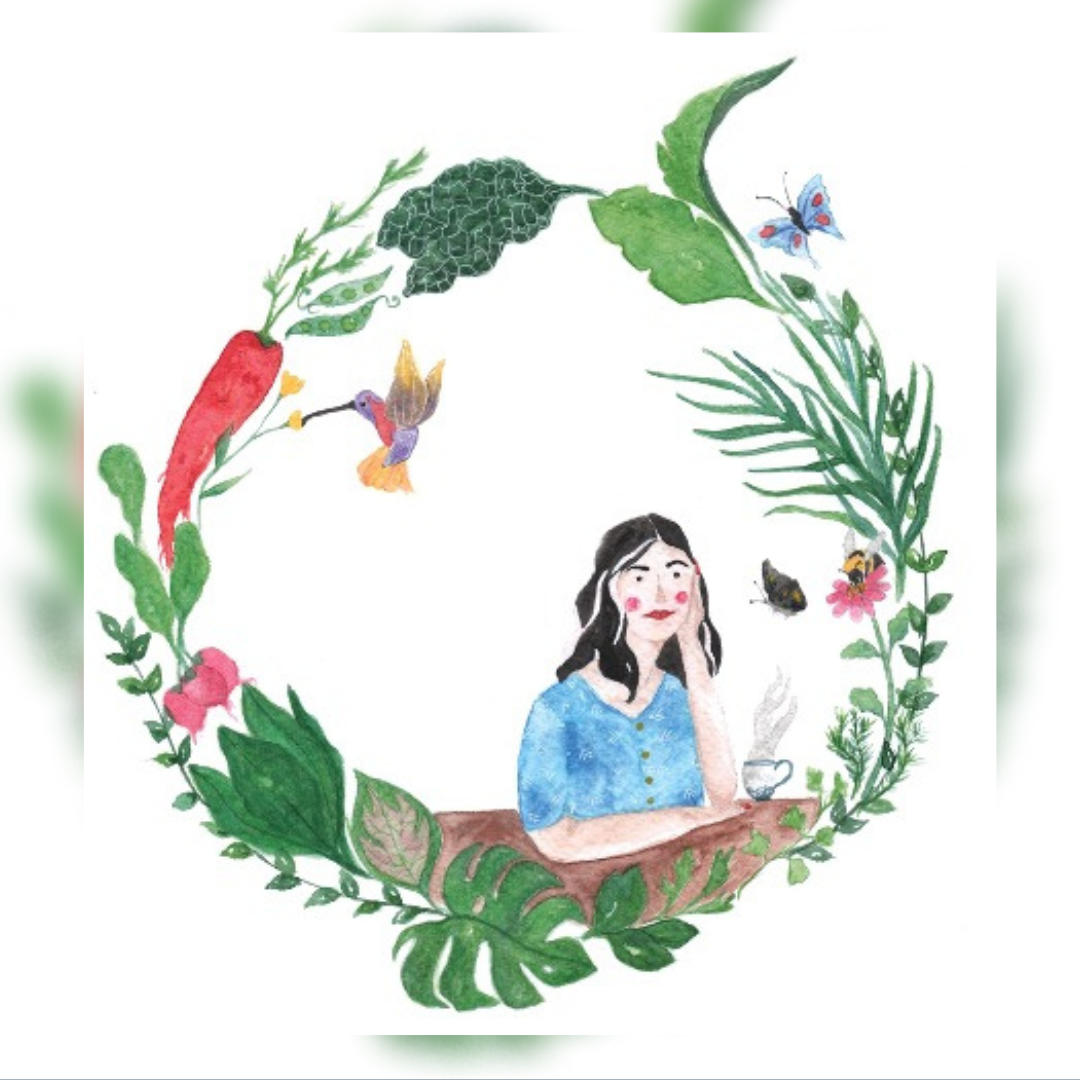
11
My father-in-law has been a seasonal farmer for over 10 years. He grows rice, beans and groundnuts. Until recently, he was always successful in harvesting his crops. Two years ago, he began to experience losses from animal evasion of his farmland.
Nomadic herders migrate from place-to-place following rainfall. Recently, herders have been complaining that grass is no longer growing, and they must feed their cattle on farmland. If they don’t, their animals will die. Every planting season, my father-in-law has anxiety of possible farmland invasion by cattle relocated due to drought. They cause disaster every planting season, leaving us, and others who depend on his produce, with hunger.
- Uchenna Prince Obiodu

12
When I was growing up in rural Central Kenya there was plenty of rain. The land was green, and crops were plentiful. I used to admire the many butterflies and birds that adorned our landscape.
In recent years, my environment has drastically changed. The seasonal rains that support crop production have disappeared, the sun is hotter, and the rivers have dried up. Drought, food shortages, and malnutrition are spreading. We are experiencing a food crisis. Our wildlife is declining, and the once celebrated rains have now turned to floods. This is not the country I grew up in anymore.
I have devoted my life to saving my dear country from the monster of climate change. My dream is to see the beautiful green and healthy country I grew up in again so that my children, and their children, can enjoy and benefit from its beauty.
- Benson Hika Mwangi

13
To be in the company of those who help defend and mend the Earth was an unfolding gift. But soon, seeing the weariness and burn out of activist friends worried me. And given my peculiarities, story and comic art became my ways of responding to this ever recurring ailment. As well, could they not be preventative medicine? For at times, surely Art can help us hold to the good and beautiful around about us.
Articulating these delights with firm whimsies may evoke thanksgiving. And to say the sorrows with a kind of humour can be crucial. In their ways, satires can help undress the ploys that dominating powers wear as they carry on the savaging of the watery animally earth. And so with different tunes our emergencies have me playing as we dance together between YES and No, celebration and protest, each with their own tears and laughter. After all, the situation is serious, so we must stop not playing.
- Bob Haverluck

14
Wherever we go, we as Marshallese will still follow our cultures. It doesn't matter where we are - we will still follow our culture. Culture that you learn is part of you - just like the organs inside of us.
My art shows an astronaut performing a traditional Marshallese fishing method. You can see that the planet is different from our planet, Earth. He still follows his culture. For his efforts of following the old ways, he caught a green alien like fish for food.
- Kiyoshi Tadashi

15
Art has been a part of my life for as long as I can remember. I also grew up with the binary belief that one must choose between the arts or STEM (science, technology, engineering, math); both was not an option. Ultimately, I chose to study environmental science because nature and especially water hold a special place in my heart.
It wasn’t until I experienced some debilitating injuries that I realized how much I missed art, and how disconnected I had become from my creative self. In graduate school I questioned why art and science can't coexist.
My masters thesis, which aims to understand how a changing Arctic will affect freshwater security, now lives in the world of science, the world of art, and the space in-between.
My painting ‘Permutation’, shared here, is a culmination of months of many different emotions; sorrow, the joy and serenity of connecting with the land through the pandemic, frustration with uncertainty, re-channeling my motivation for research into brushstrokes rather than written words, and the catharsis from being able to reignite my passion for research and water through the sharing of my colorful healing.
- Megan Leung
16
Le calvaire des sensibles
Ce pays est nocif pour les âmes sensibles
Chaque larme déversée laisse dans le coeur une crible
Chaque histoire triste dessine une ride sur le visage
Je revois avant de dormir toutes les tristes images
Je ne peux pas passer à côté d’un misérable
Qui n’a ni une maison, ni du pain sur sa table
Comme si je passais à côté d’un arbre,une statue
L’empathie m’étrangle et l’humanité me tu
- Leila Bassil
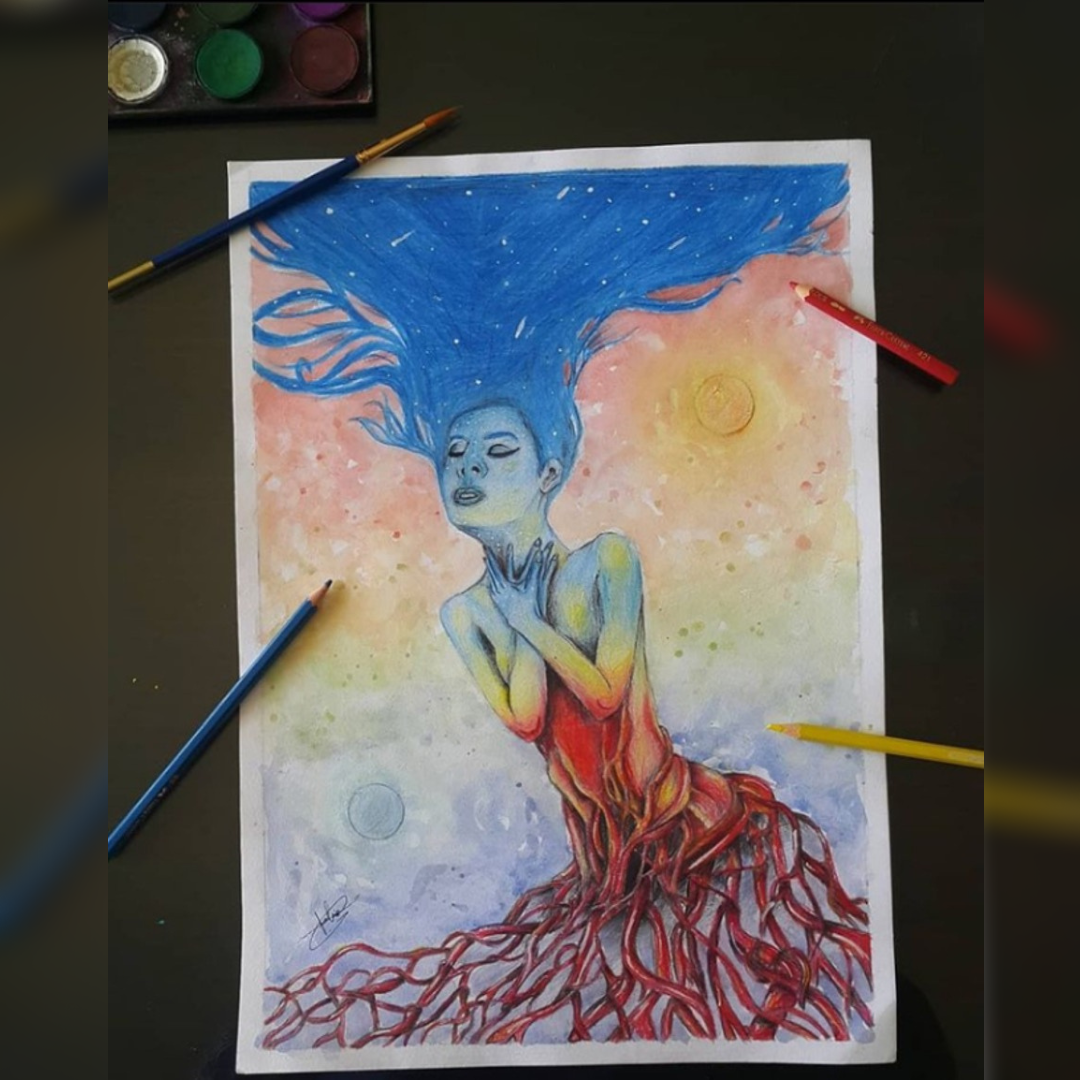
17
The painting visualizes our future when we have no choice left but to migrate to larger land. Although we try our best to keep the culture alive, we cannot avoid geographic difficulties that keep us from passing down the tradition.
Amimono, a traditional weaving technique, is a good example. In a foreign place, pandanus leaves are hard to find. Without the material, we cannot make original Marshallese handicrafts. We will have no choice but to adapt to a new culture and use whatever materials we can find to substitute the traditional maañ, or dried pandanus leaves.
- Haruka Sato
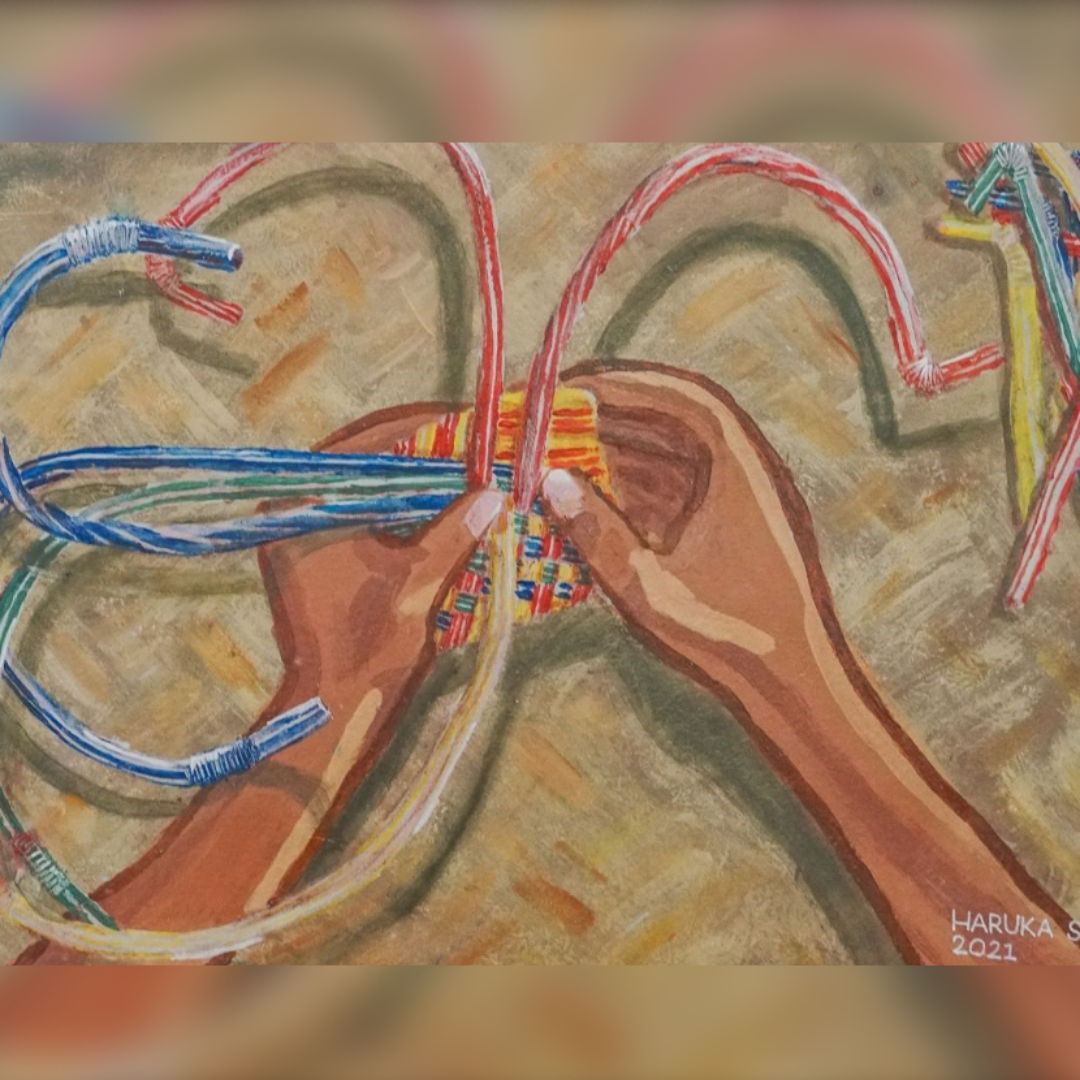
18
I have long advocated for the creative community to be involved in changing mindsets, enhancing awareness, and encouraging community engagement in climate action. How can we be part of the solution to the negative problems climate change has brought to the world, our common home?
- Halisi Monray

19
Une belle empreinte 100 ans ne sont rien comparés à l’âge de l’univers Et comme on est petits face à la planète terre Qui gravite une étoile le soleil parmi tant d’autres
Parfaitement habitable, cette planète est la nôtre L’homme face à cette immensité est de la poussière Soit il choisi d’être bon, indifférent ou pervers Cet univers d’atomes est un visiteur dans ce monde Toute sa vie peut se bouleverser en une seconde
Il tangue lassement entre le mourant et l’éternité Perdu entre les guerres et conflits et la fraternité À lui de choisir quelle empreinte il désire laisser Il peut semer l’espoir et la joie ou les effacer Il peut voler les sourires ou même les tracer Se mobiliser contre le changement climatique Ou regarder la fonte des glaciers de l’ antarctique
Ô combien c’est beau de laisser un impact positif ! Surtout qu’on ne possède pas un habitat alternatif Si notre planète se dessèche notre espèce est vouée à l’extinction C’est après une bonne réflexion que vient la bonne action
- Leila Bassil
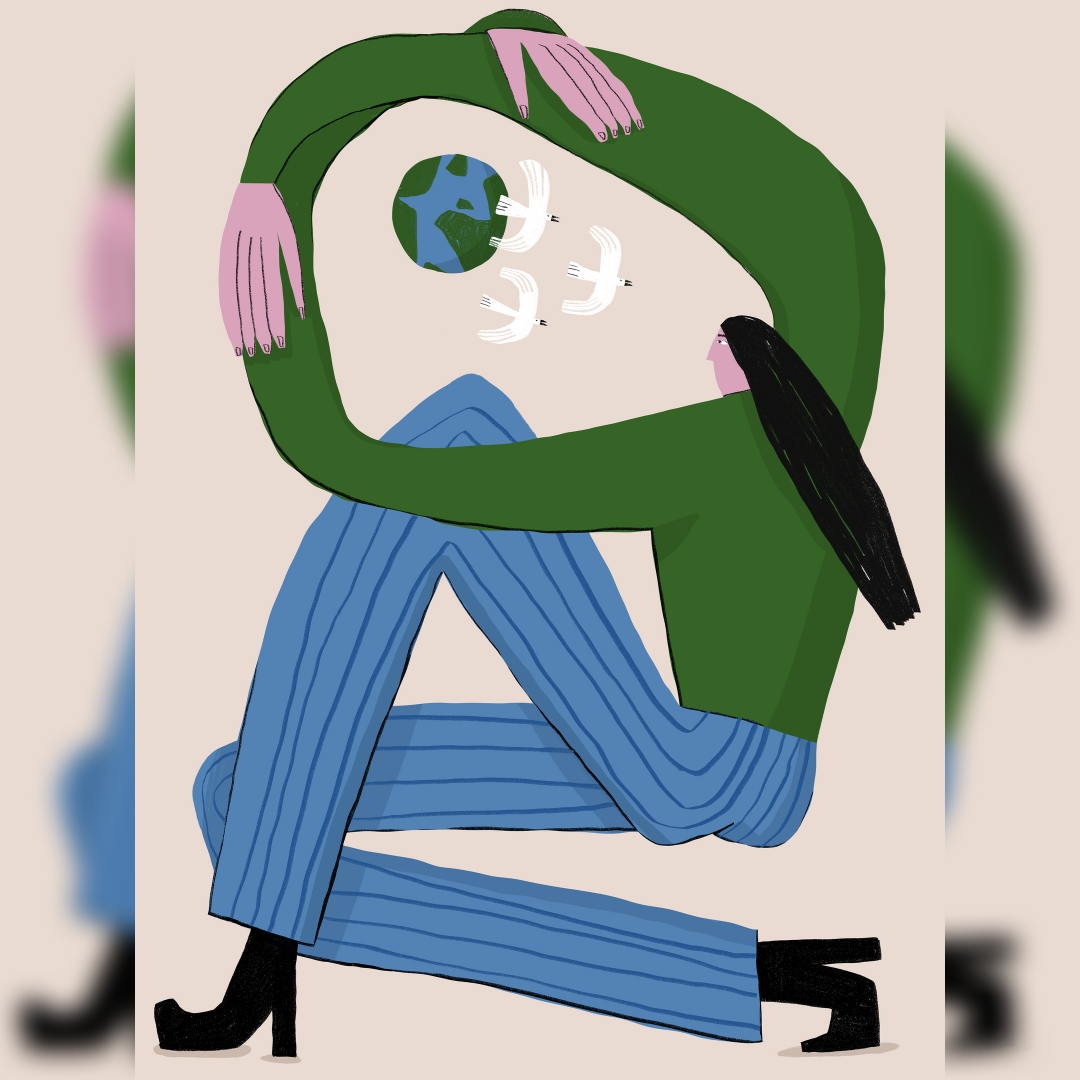
20
It is hard to think about the future.
A week ago, my first nephew came into the world, and suddenly, the future became personified. I imagine what his future might look like. I wonder what will be his normal. Just as slowly, over time, previously unheard of weather has become my normal.
Will he have to check air quality and wear air filters before venturing outside his home? Will he adjust life to fit a carbon quota? Live indoors entirely sequestered from an uninhabitable environment? Will he live in a way entirely removed from how we do so now?
Optimistically, I like to imagine an attunement to the environment far beyond what we have currently. A world where we have learned from the mistakes of our past and moved forward into a more respectful and reciprocal relationship with nature.
And so, new images form: my nephew sitting with his fingers dug into the earth pulling out root vegetables, the sound of laughter as he speeds down a car-less road on his father’s old bicycle, and him at the end of a hike admiring the forest whilst breathing in fresh, clear air.
It is this image of what future generations could have, and its correspondent call to not give up hope even in the face of present climate uncertainty, that should spur us on in our work to redress climate change.
- Sarina Chandaria

21
I am a climate change ambassador and a person with a disability. I fight for the inclusivity for persons with disabilities who are facing challenges from climate change. More often than not, society does not bother to care about our vulnerability. I have been fighting for climate resilience for youths and persons with disabilities. We need to solve daily challenges including poverty, accessibility, infrastructure, and disasters. We want to live in a society which is inclusive by supporting and helping people vulnerable to climate change.
- Johnkeen Ochieng

22
The 2018 heatwave in the UK was the moment where I personally realized the massive danger of extreme heat. It was one of the most intense moments I've ever lived, where I was not only worried about me, because it was so hot, but also about my baby, as both children and pregnant and lactating mothers are at greater risk of heat-related complications. It was truly a moment where vulnerability is real, where life is at stake.
With hazards like heatwaves, what is the most fascinating (and most hopeful), is that very simple actions can save so many lives and can make lives so much more comfortable.
In that July of 2018, I thought deeply about key long term actions that decision makers must take to ensure the safety of society. And also that short simple actions like finding shade, drinking more water than you think you need, resting more, and looking out for other people, can save your life and others - that is very powerful.
- Catalina Jaime
Photographer: Ruskin Kyle
Illustrator: Andrew Rae
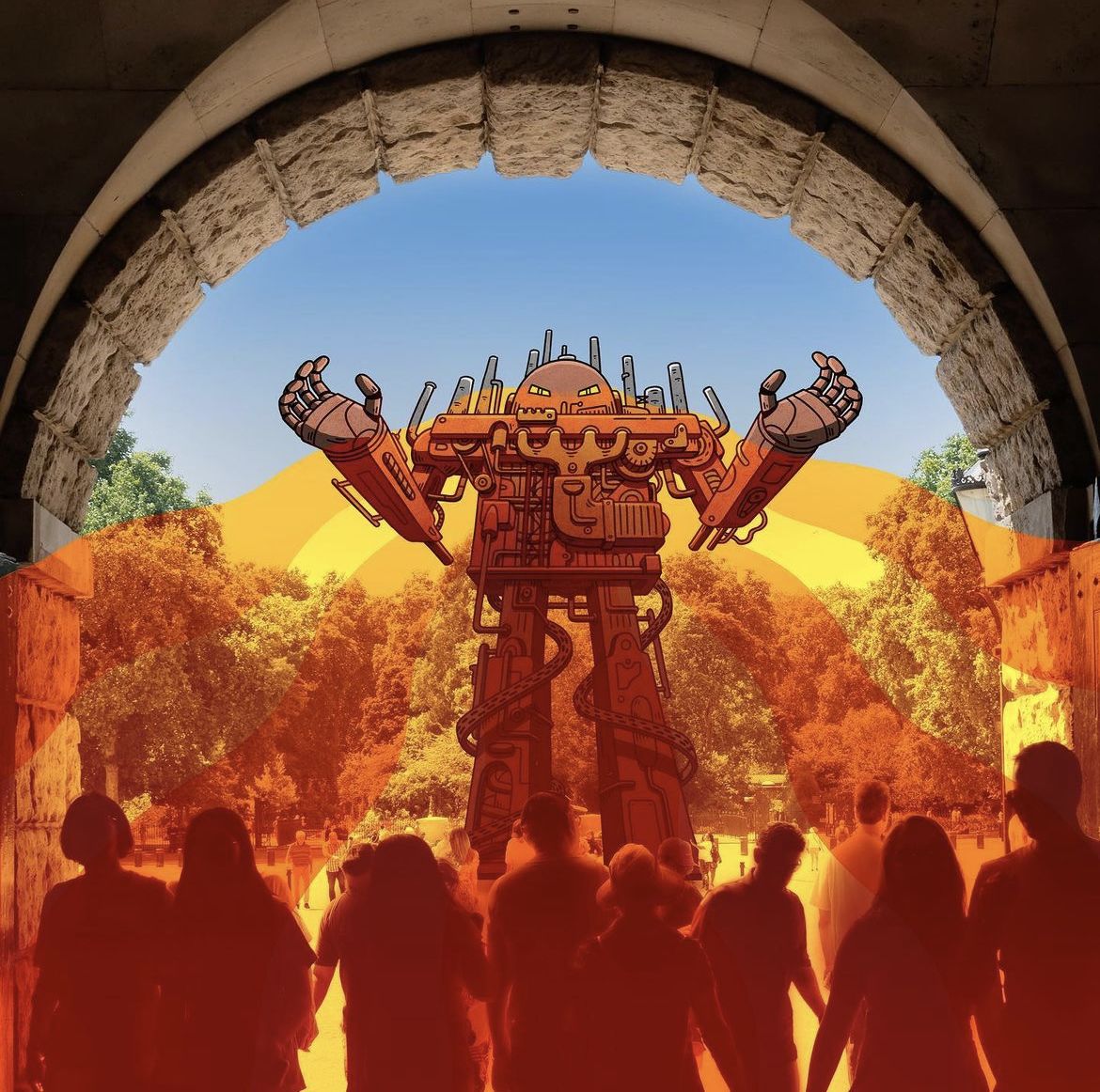
23
‘Environmentalism without class struggle is just gardening’, is one of the famous sayings of Chico Mendes, the Brazilian activist who was murdered for his fight for environmental justice in the Amazon in 1988. Even though this might be provocatively phrased, it is an important reminder of how, even today, environmental challenges are inextricably entangled with social challenges.
Simply said: we are not all affected by climate change and environmental collapse in the same way, and that means there is not one solution for it either. If we were to even speak of a solution, it would lie in a plurality of approaches; from local to international, from technological to makeshift, from scientific to indigenous, from ambitious to humble, from political to artistic.
- Yasmine Ostendorf-Rodríguez
Artist: studio PUNKT

24
Sitting in my chair across from three Yemeni elders, lovingly called the three wise men, I felt connected in a way that I didn't think possible in a country so different from my own. This place was suffering from the toll of conflict, from uncertainty of what tomorrow would bring and from the consequences of climate change.
The last few years had seen reduced rainfall and water shortages through much of the country. Economic hardship reduced the ability of communities to respond when disaster strikes. The same was true for these three elders. Over the months I got to know them, the elders shared how climate change had impacted their water supply and ability to farm, coupled with compounding risks from ongoing conflict in the country.
Many people had begun to leave the village due to livelihood challenges or switched to local cash crops like qat to bring in money. But hearing their stories of crop failure, of drought, of seasons changing in ways they hadn't seen before, I recognized patterns I had been seeing in my own home. Even though the consequences and impacts may look different because of the societal context and structural capacity to adapt, it opened my eyes at a personal level to how we share concerns of the ways climate change is affecting our societies.
Regardless of how our daily realities may have differed, we connected on how climate change is an urgent issue at the global and local levels. While it was a sober experience, it also demonstrated the opportunity we have to use our diverse backgrounds and experience to try and mitigate and adapt to the challenge of climate change.
- Sarah Gale

25
Some rural communities in Zambia rely on electricity for their livelihoods. In the rural Kasokota community, peers often have to travel to neighboring towns to access a milling machine.
The diesel-powered machines are large, and fast, but the cost, reliance on diesel, and health impacts of the exhaust fumes from poorly maintained diesel engines, leaves room for improvement. There is also anecdotal evidence that the user experience can involve long waiting periods for enough customers to arrive, for it to be worth the operator switching on the machine, due to the inefficiencies of the diesel engines, especially at start-up.
Because of this, there is potential for utilizing renewable energy sources to power local mills. Solar energy is becoming more widely utilized in remote regions of Zambia. Our projects use a solar energy system to replace thermal engines and increase community access to electricity.
- Mweetwa Mundia Sikamikami
Artist: Burcu Koleli
26
Cry! Cry! Emergency is coming. Warming intensified. Sea rising, ice melting, land shrinking. Everywhere, women, animals, children suffer. The green curtain is torn under the effect of deforestation and the intrepid posture of poachers. Environmental awareness oscillates between energy, industrialization, and overconsumption. But who defends the environment? Citizenry is thirsty for collective action.
- Benedict Djekomian
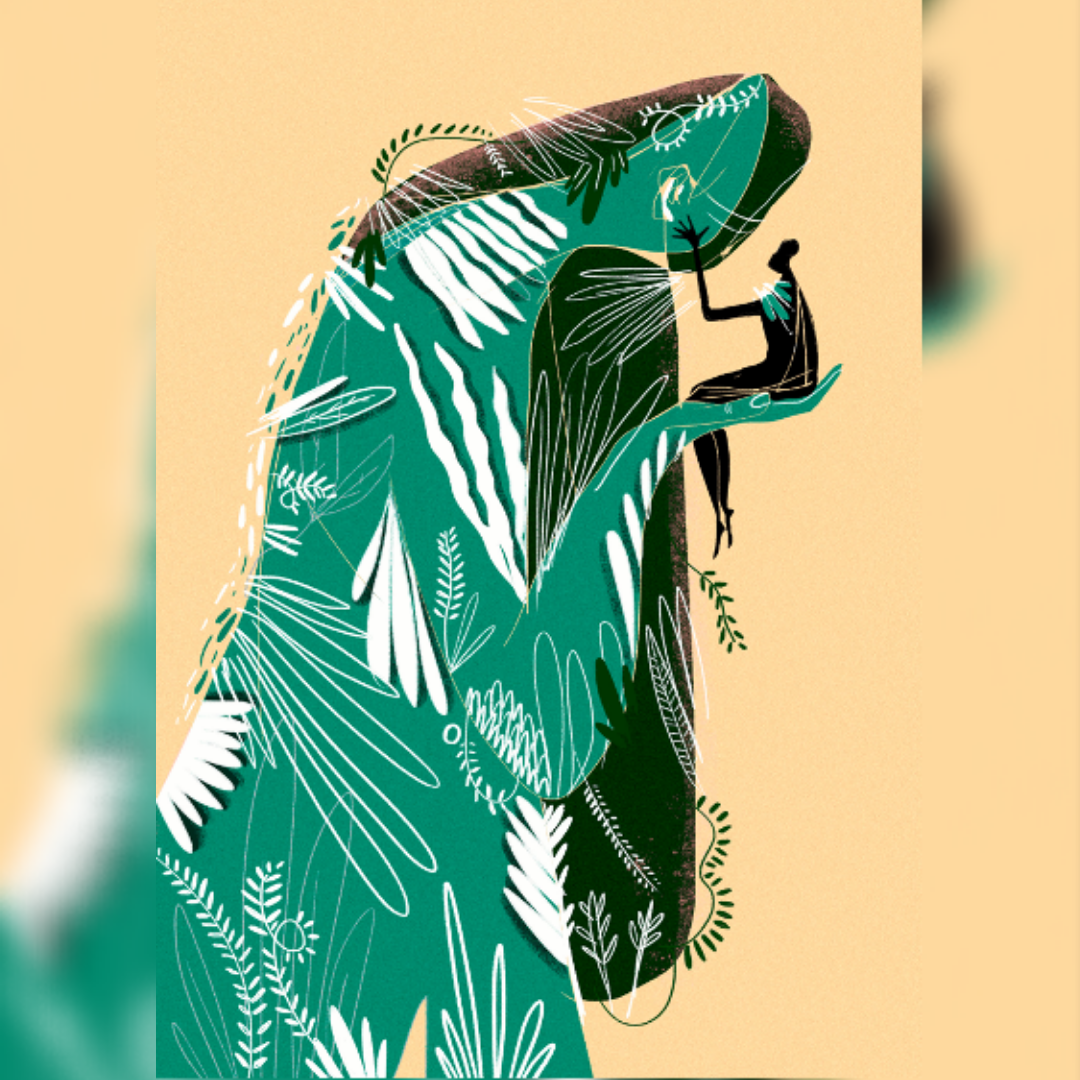
27
This story takes place one night in Buenos Aires where we’re about to start a cardboard puppet theatre show. The show is about an Argentinian cow who organizes a mass cow-escape to India to save themselves from certain death in the slaughterhouse. Suddenly we can smell smoke. The whole theatre can smell the smoke but the place isn't on fire.
Omar, the owner of the theatre, had been talking earlier about how far away the climate crisis and associated conflicts seemed. We learn that the origin of the smoke is a combination of fires created intentionally to burn pastures and wildfires induced by extreme heat and drought. The combination of all this will lead to lost livelihoods, an increase in poverty, and human and animal suffering. The smoke originated in the province of Entre Rios. Omar’s theatre is in Buenos Aires…320 kilometers away.
- Ham & Eugenia
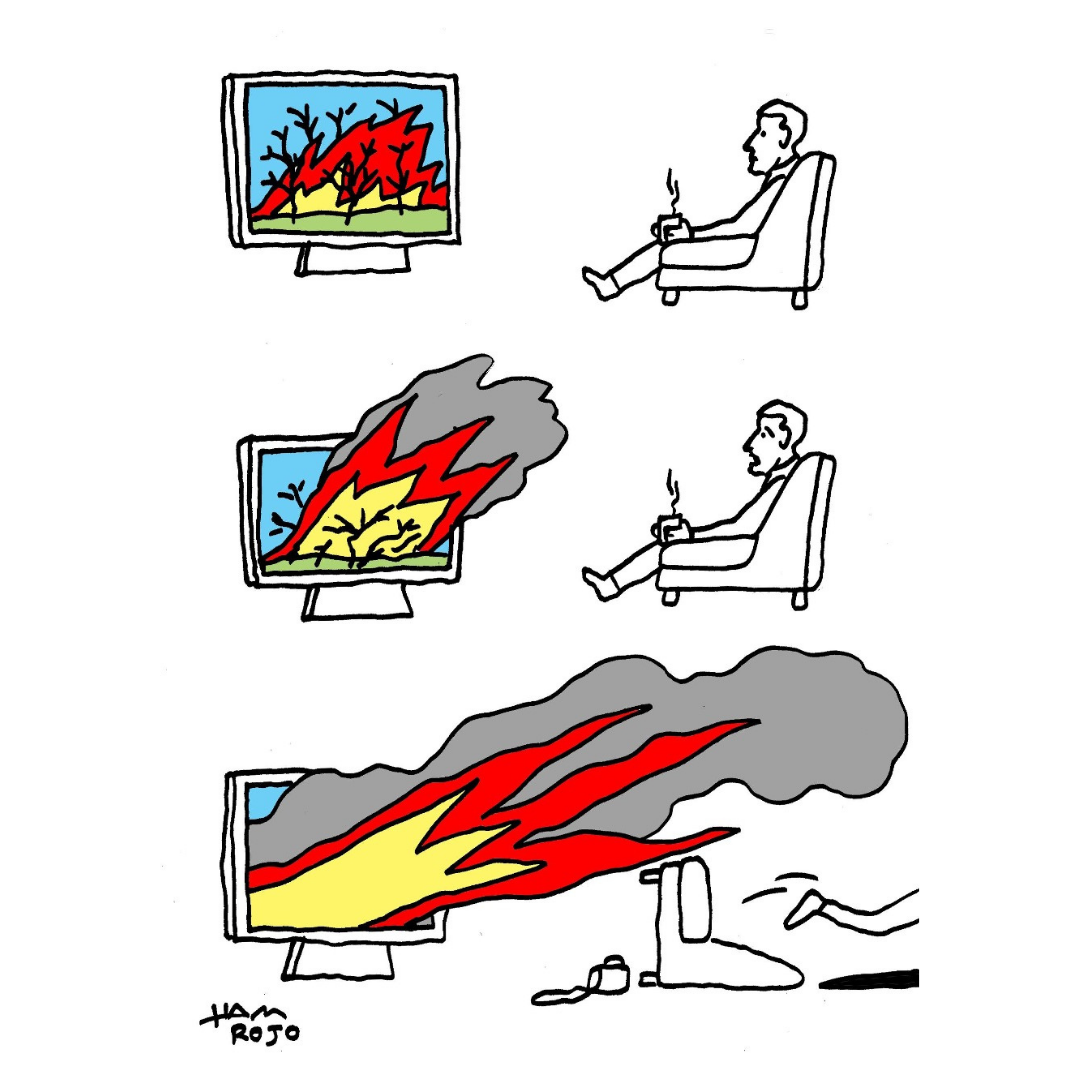
28
As a youth, I have witnessed deforestation and destruction of wetlands in my community and this has not only affected the elderly people but also the young people through physical and mental health burdens due to diseases, limited access to clean water, landslides, and flooding. Crop destruction and agriculture decline has contributed to hunger and vulnerability in most communities. I believe raising the voices of young people on climate action will bring about sustainable innovation and development.
- Gwendolin Asiimwe
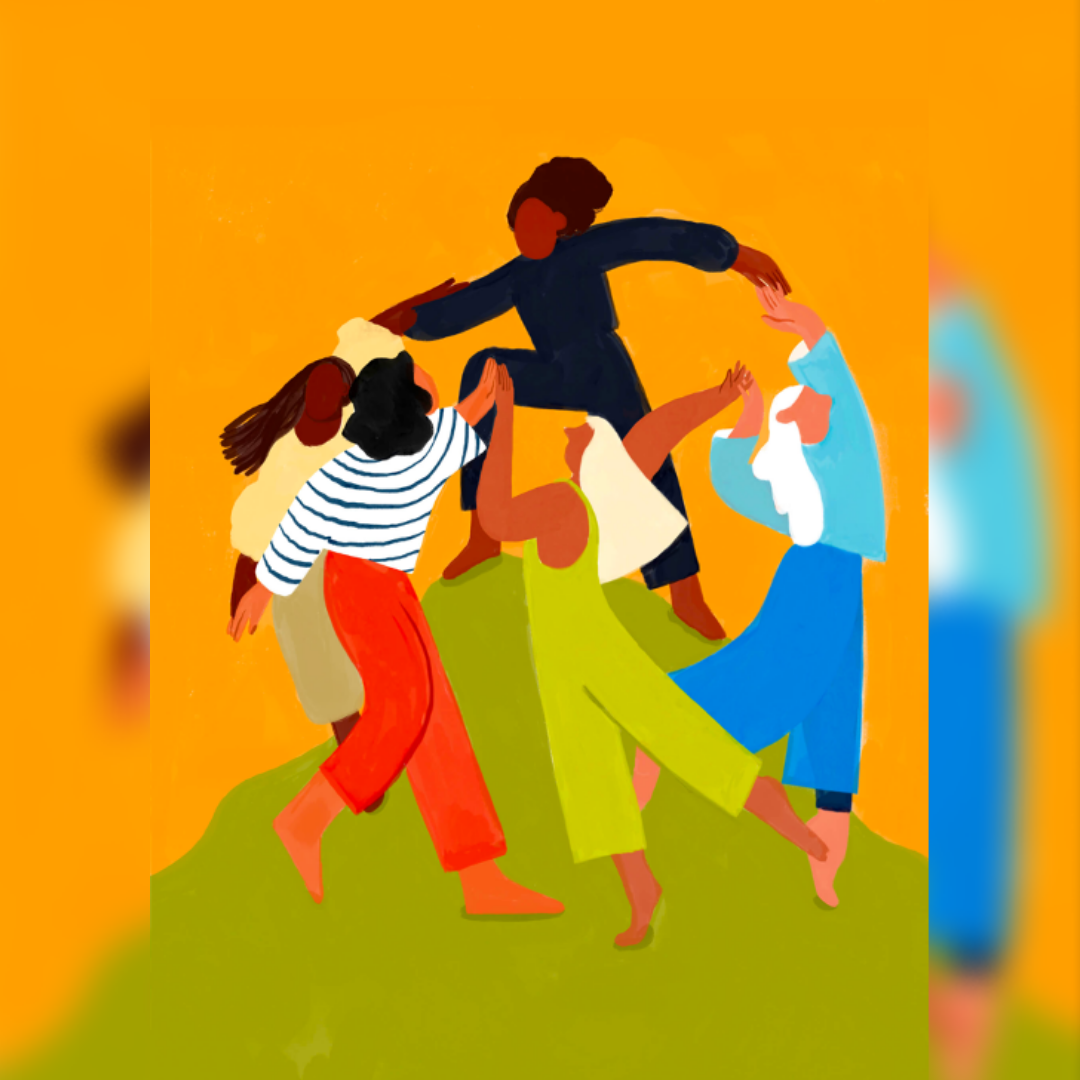
29
It was a brilliant November day in 2021. We were exploring the Sculpture Gardens exhibition at the Auckland Botanical Gardens, New Zealand. I stopped in front of a sculpture, by Natalie Guy, about 5 metres tall - a series of three shapes rather like symmetrical North American totems. Only after reading about the purpose of the shapes, was I fascinated by Natalie’s impressionist “trees”.
The shapes were based on Indian architecture developed to cut heat, deflect some sunlight, allow light, and breeze to flow into the building, protecting the users of the buildings from the elements. The sculpture was inspired by architect Jane Drew who designed buildings to protect from tropical conditions.
Months later, at a lecture by Matthew Cherisich, I learned about the impacts of heat on pregnant women in rural South Africa. Mothers and children are especially vulnerable to heat exposure. My thoughts brought me back to the sculpture by Natalie Guy. I wonder how we can bring purposeful architecture and sculpture to reduce the burden of heat on pregnant mothers?
- Lily Mitchell
Illustration: Devin O'Donnell
Photograph: Natalie Guy
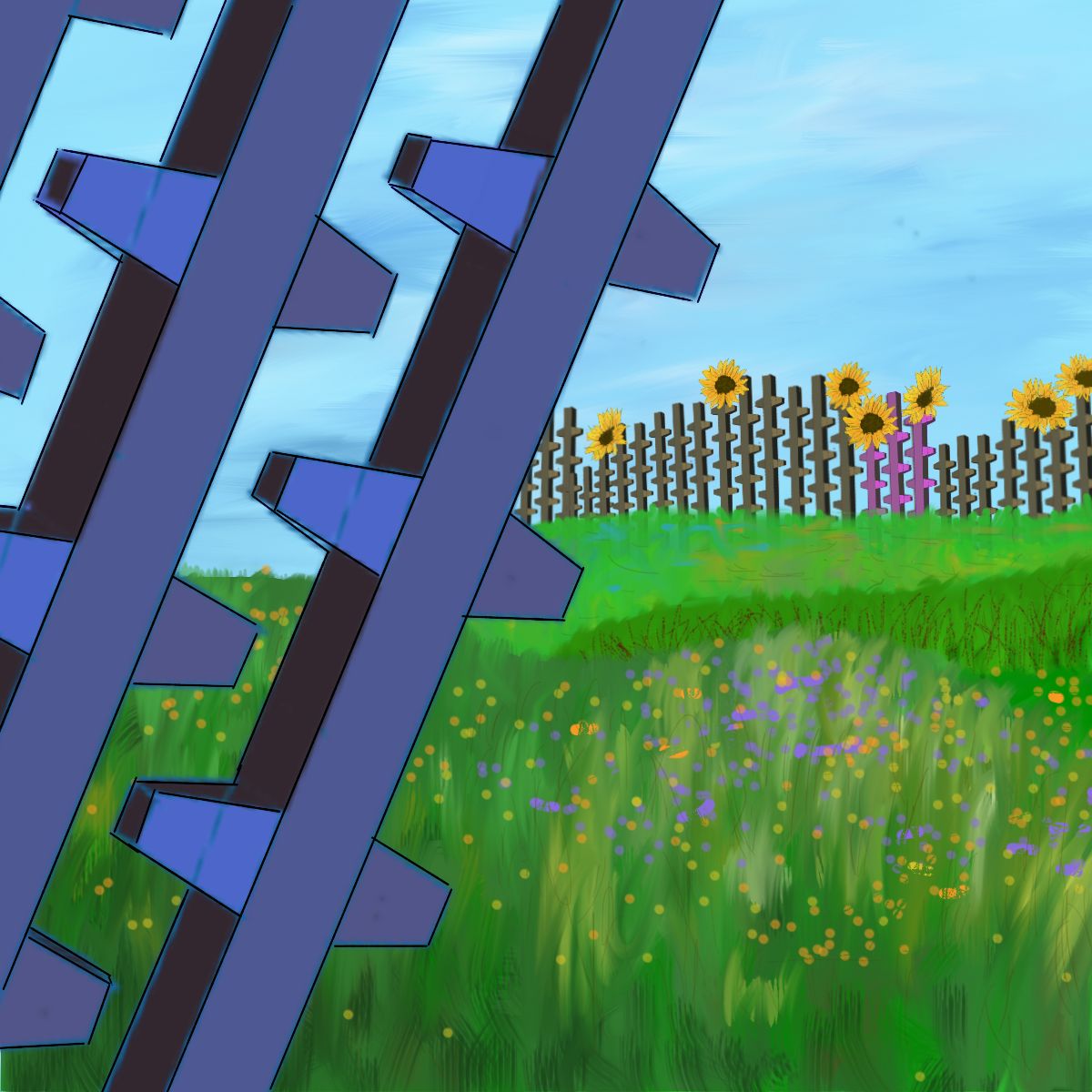
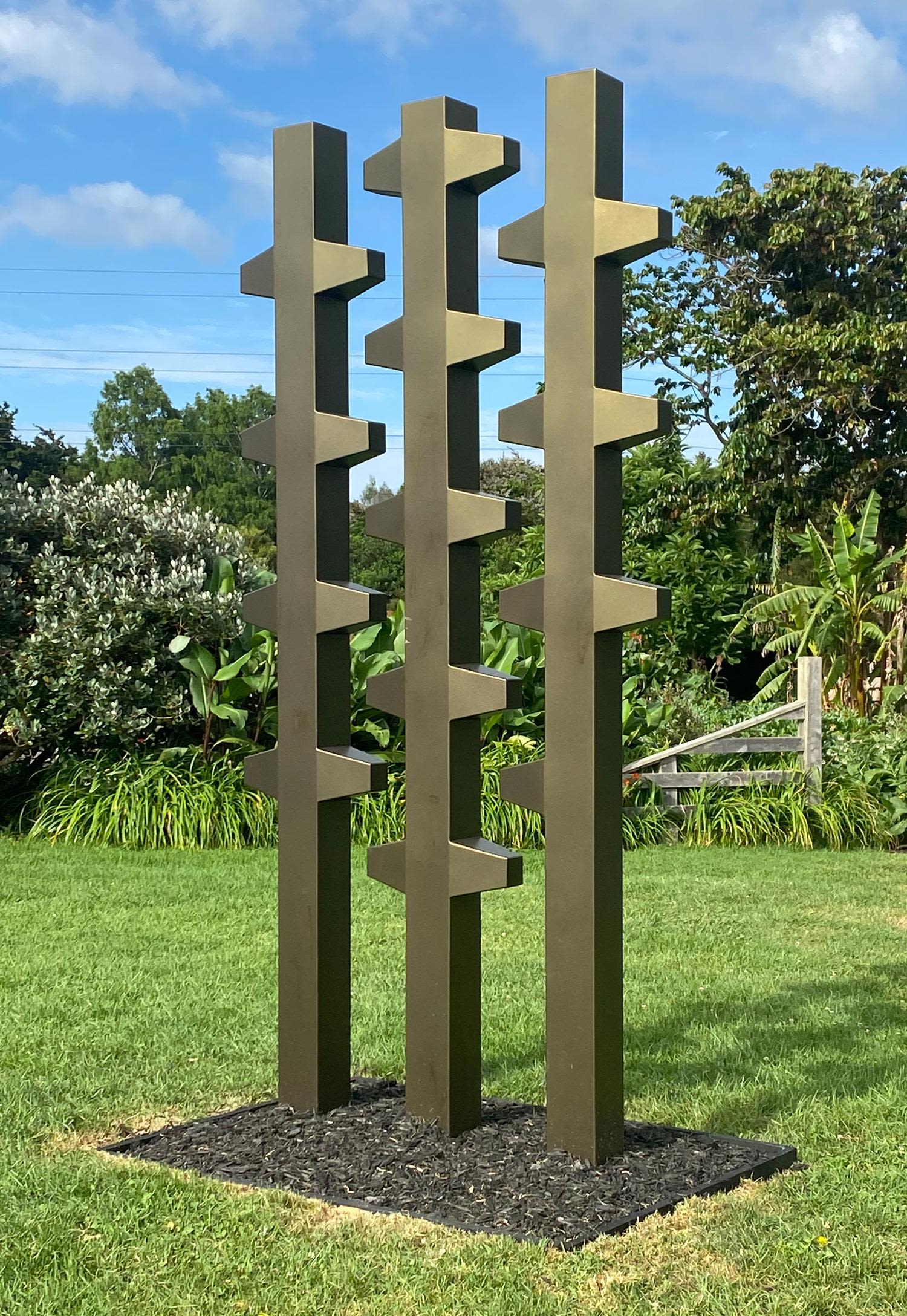
30
Severe flooding and landslides caused by heavy rainfall is a major cause of death and destruction of property. Politicians have contributed to the risk of destruction by encouraging people to occupy private vacant land not suitable for human settlement. Most informal settlements that are built in low-lying areas are vulnerable to floods and landslides, and also fire due to close proximity and overcrowding. We need to encourage community and government engagement to avoid disasters influenced by power, where politicians gamble with people's lives for votes. Unfortunately, they rarely take responsibility when lives are lost and people are left homeless.
- Bethuel Mangena
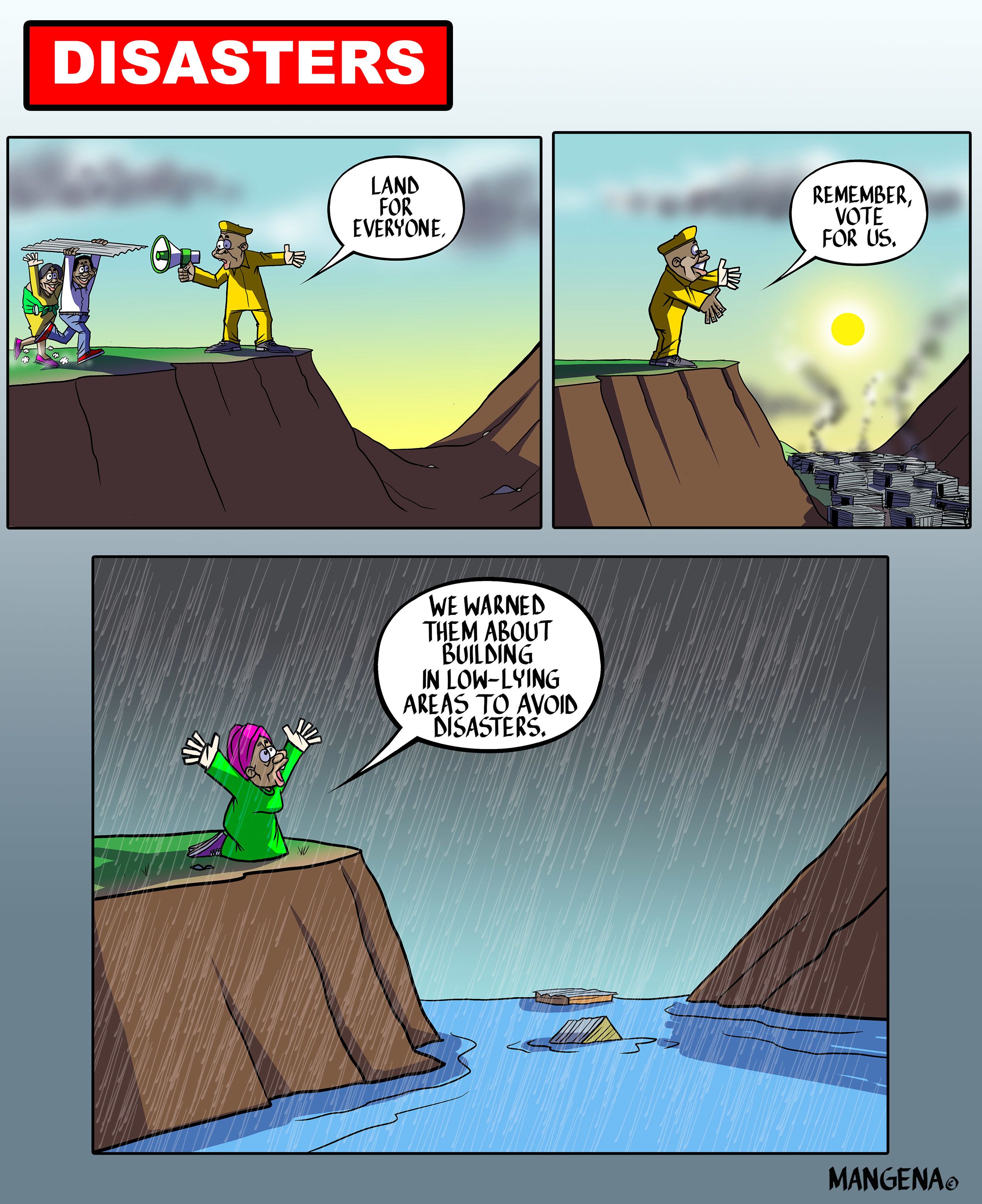
31
I understand environmental sustainability in the visual arts as a way to demonstrate entanglements and plurality: no single-issue environmentalism and eco-colonialism, but whilst reducing carbon-footprints, increasing kindness footprints. A kindness footprint would include solidarity, care, creativity, love, compassion, multi-sensorial listening, honesty, hope, nuance and complexity, vulnerability and colour (including of our skins).
As a sector we need to amplify the voices of artists and art organisations responding to the various social and environmental issues that are the result of the dominant systems that are (still) informed by (neo)colonial, patriarchal, extractivist, and capitalist power structures. After all: our histories, present, and futures are entangled.
We rapidly need to be making the world a more just and livable place and that means saying goodbye for good to the systems that don’t serve nature as a whole (humans included).
- Yasmine Ostendorf-Rodríguez
Artist: Ipsita Divedi
Thank you to all the artist and storytellers who graciously shared their work with us.
Artwork from The Greats shared with permission under CC-BY-NC-SA license.

